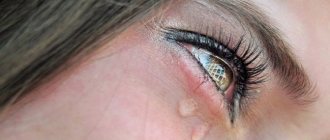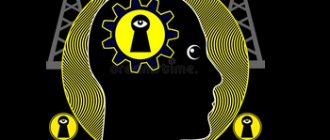Scientists are tirelessly conducting research trying to understand its cause. Today, there are a considerable number of hypotheses suggesting the development of schizophrenia.
Physiological basis
The development of the disease is based on the pathologization of the physiological processes of the brain, which provoke an imbalance in the psyche and its productive symptoms.
The dopamine theory is considered one of the most reliable. According to it, schizophrenia is caused by ultra-high or ultra-low levels of the neurotransmitter dopamine, which are persistently maintained for a long time. If there is too much of it, then productive symptoms of the disorder appear: delusions, hallucinations, disorganized thinking. If its quantity is at a low level, then negative symptoms predominate: apathy, lack of will, depression.
In addition to dopamine, there is an imbalance of other mediators: GABA, serotonin, acetylcholine, norepinephrine, glutamate.
A connection has been established between the malfunction of the liver, the endocrine system (resulting in a disruption of protein metabolism) and schizophrenia.
However, when the disorder occurs, not only the chemical balance is disrupted, but also the structure of the brain tissue itself.
Thanks to brain imaging methods, scientists have been able to establish what happens to the brain of a person with schizophrenia. These methods include:
- MRI;
- CT;
- spectroscopy;
- diffusion-weighted MRI;
- perfusion-weighted MRI;
- positron emission tomography.
First of all, such patients suffer from a deficiency of neural processes. Consequently, the number of synapses transmitting nerve impulses decreases.
Secondly, as it turned out, the volume of brain tissue in such people is less than normal. The amount of both white and gray matter decreases. The lack of white matter plays a major role in the occurrence of such pathological signs of the disorder as impaired attention, memory, thinking, apathy, loss of the ability to set goals and go towards them.
This is due to the fact that the substantia white contains long myelin fibers that connect parts of the brain. Naturally, as the volume of white matter decreases, there are fewer of these fibers. The connection is interrupted, thereby disrupting the coordination of the brain.
During puberty, a slight loss of gray matter is considered normal. The problem can arise when brain mass loss occurs rapidly.
It is not yet possible to determine the exact cause of brain matter deficiency. It is assumed that an inflammatory process in the brain may be to blame. It destroys neural connections, which causes disorganization of the brain, and with it the psyche. Among the contributing factors that cause inflammatory reactions in the body are neuroinfections: meningitis, encephalitis, etc.
The surprising thing is that destructive changes of this kind are visible during the study even before the manifestation of the disorder.
Diagnostic features
Psychiatrists know what schizophrenia and paranoia really look like, so diagnosis is not difficult:
- The examination begins with a conversation. The doctor determines the stage of development of the disease, identifies the causes of its occurrence and assesses the mental state.
- Parapsychological tests are aimed at identifying mental disorders characteristic of a personality disorder. Laboratory methods include neurotest.
- Using blood tests and physiological indicators, mental abnormalities are diagnosed and the severity of the disease is determined.
Other physiological reasons
Among the pathological processes in the body in schizophrenia there are:
- immune reactions;
- endocrine imbalance.
The immunological effect that provokes the development of schizophrenia has two directions.
The first is that the immune response becomes distorted in response to the virus. The second lies in the autoimmune process, when one’s own immune cells destroy brain tissue.
In endocrine imbalance, a special role is played by hormones such as insulin, prolactin, and growth hormone.
Physiological theories of schizophrenia became the impetus for the development of such treatments as insulin therapy, during which the patient was injected with high doses of insulin and put into a hypoglycemic coma.
Psychotropic drugs made it possible to achieve a balance of neurotransmitters in the central nervous system, which was a big step in relieving the disorder.
Genetics and heredity
The genetic theory that explains why schizophrenia occurs plays an important role in the overall picture of possible causes provided. However, it has not yet been fully clarified which gene is responsible for the appearance of the disorder. Previously, 72 genes were classified as such, but this has never been scientifically confirmed.
It is believed that genes responsible for the exchange of neurotransmitters play a special role in the development of the disease. If a defect is formed in them, then the mediators are either released in insufficient quantities, or their structure is changed, and the receptors do not recognize them. As a result, the transmission of nerve impulses is disrupted, and, as a result, disruptions in the activity of the central nervous system appear.
Depending on how affected a particular gene is, a person may:
- be a carrier of a pathological gene that manifests itself in subsequent generations;
- have a schizotypal disorder;
- suffer from schizophrenia.
Despite the fact that there are many gaps in the genetic theory of schizophrenia, the fact remains. There is a sad dependence of the inheritance of the disease if one of the relatives has the disorder:
- one parent is sick - the risk of children getting sick is 15%;
- both parents – 45%;
- grandmother or grandfather – 10%;
- great-grandmother or great-grandfather – 5%;
- siblings – 5–10%;
- cousins, aunt, uncle – 2%;
- nephew – 2%.
If the mother is the carrier of the disease in the family, then the risk of inheriting it from the child increases than if the father is sick.
Psychosocial theory
All of the above reasons for the development of schizophrenia relate to medical or biological theory. However, there is another group of factors involved in the manifestation of the disorder. It includes a model of raising a child, in which the main role is played by the mother. There are several maternal positions that provoke the development of the disease even in adulthood.
Schizophrenogenic mother . This concept comes from psychoanalysis and refers to a woman who completely dominates her child. She is cold, insensitive, and does not take into account the interests of her child. One of the main features of such a mother is complete control. The child cannot take even the slightest step without her intervention. She constantly monitors his actions, does not give him freedom and the opportunity to learn to adapt, to look for a way out of the current situation. In general, it deprives him of independence.
Such a mother does not pay any attention to the desires and needs of the child. It seems that the baby in her hands is a tool for satisfying her ambitions and unfulfilled hopes. She makes decisions for him, and in some situations this reaches the point of absurdity. For example, such a parent will force the child to play with a green car, despite the fact that he desperately wants a red one.
Mothers of this type take away from their children the opportunity to independently comprehend the world, overcome difficulties, and adapt to life in society. As a result of this, the child develops isolation, isolation, and the inability to establish contacts, which subsequently leads to the development of the disorder.
An overprotective mother is not characterized by strict control and dominance. She strives to satisfy all the needs of her child. She takes care of him, indulges all his desires, fulfills all his duties for him. For example, such a child does not know how to collect his toys, make his bed, or put his clothes in their places.
An absent mother takes virtually no part in the child's life. She provides care, makes sure that the baby is fed, dressed, and shod, but there is no emotional connection with him. The child does not feel support, attention, or instilling confidence, but receives only reproaches and indulgence. As a result, an already matured person feels flawed, not “good” enough, he does not believe in his own strengths, and does not feel self-confident.
Destructive mother . This model corresponds to a cruel, violent attitude towards a child, both physically and morally. Such upbringing disrupts the process of development and personality formation, leading to psychopathy. In the future, they can transform into more serious mental disorders, including schizophrenia.
Example: a 28-year-old guy calls himself a descendant of Nicholas II, claiming that he is his illegitimate son. Delusions of grandeur are accompanied by characteristic behavior: deliberately correct speech, gestures with a shadow of superiority, mannered movements, the characteristic proud posture of a patient with schizophrenia.
According to the mother, the delirium began 2 days ago, before that there was a change in behavior. The guy became silent and treated her with disdain. He became secretive and locked himself in his room. He spent nights sitting in it, not sleeping. He was excited and nervous.
During the survey, it turned out that mother and son live together. The guy works from home and does online sales. All housework and housework falls on the mother's shoulders. She cooks for her son, washes, irons, looks after him from all sides. According to the mother, her son has practically no friends, and neither do girls. He spends all his free time with her, they go for walks, shopping, etc.
As a child, my son was also not very friendly. At school he often had problems with his classmates. He was considered a black sheep, called a mama's boy. The guy did not know the father, since he left the family when the child was one year old and does not maintain a relationship.
The example shows how maternal overprotection served as a reason for the manifestation of paranoid schizophrenia.
Recently, scientists have been quite active in talking about the “stress-diathesis” model in the formation of schizophrenia. Diathesis is a person’s biological predisposition to a disease. This could be a genetic failure, heredity, neurochemical, endocrine imbalance, autoimmune reactions. But the presence of such defects does not mean that a person will necessarily develop schizophrenia. For its occurrence, it is necessary that such a “diathesis” react with a predisposing factor. In this case, such a factor will become a trigger that will launch the pathological process.
The provoking factor may be:
- acute stressful situation - death of a loved one, loss of social status, major financial losses;
- chronic stress is an adverse psychological effect in a small dose over a long period of time: overwork, mental pressure from others. There is a known case where schizophrenia manifested itself in a young man in the army, presumably under negative pressure exerted by fellow soldiers;
- drug addiction and alcoholism. Such psychoactive substances cause an increase in dopamine levels, and subsequently this leads to dysregulation of its levels. According to psychoanalytic theory, the change in consciousness that occurs when using alcohol or drugs leads to a weakening of the line between the conscious and unconscious. And if abuse occurs systematically, then it disorganizes the psyche;
- age crisis. Schizophrenia most often manifests itself in adolescence;
- violence – sexual, physical, psychological;
- hormonal changes - childbirth, menopause;
- loneliness, minimizing social contacts;
- traumatic brain injuries and other brain diseases.
Thus, the provoking factor plays an important role in the formation of the disorder. In a favorable environment, even in the presence of a predisposing element, the disease will remain in its infancy.
Symptoms of catatonic schizophrenia
Typical signs of this mental disorder are intermittent stupor and agitation. Let's look at each in detail.
Catatonic stupor - a person is in an uncomfortable position for quite a long time, several hours, days, months and even years. The famous physiologist Ivan Pavlov mentions a case when he was shown a patient who had been in this condition for 20 years.
A person in a stupor retains consciousness, that is, he can then talk in detail about the events that took place at that moment. He has muscle tension or waxy flexibility. He does not move, does not speak or perceive someone else's speech, does not eat or drink, and produces natural relief on his own. To maintain his vital functions, he is fed and watered through a tube. Prolonged stupor can provoke the formation of bedsores, possibly compression of large blood vessels and nerves.
The most characteristic poses for this period:
- hood symptom - twisting of the body in the form of an embryo and covering the head with a tucked-in fabric (a hollow robe, a blanket, a hood);
- Dupre syndrome (air cushion) – the head does not touch the pillow, it seems to be hanging in the air;
- the proboscis symptom is a manifestation of grasping and sucking, i.e. the most primitive reflexes.
Catatonic excitement - the patient commits stereotypical aggressive actions aimed at aimlessly destroying everything that comes in his way. If he is stopped, he stubbornly resists and can tear off his clothes. To prevent the patient from harming himself and others, he must be tied up.
In both periods, the catanonic may exhibit oneiric syndrome . That is, he will be visited by fantastic visions with himself in the leading role. He draws the content of such dreams from heard scary stories about any incidents, thrillers, detective and science fiction films or books. Dream experiences are reflected on the patient’s face, and this is especially noticeable when he is immobilized: the expression of ecstasy turns into horror, etc.
It is worth noting that experts consider the absence of oneiroid syndrome to be a bad sign that worsens prognoses.
Other symptoms accompanying the main ones:
- negativism - everything that is offered to the patient is perceived negatively. There are 3 variants of it - active (the catatonic person performs actions that he was not asked to do), passive - completely ignoring calls to him, paradoxical - the patient performs actions that are exactly the opposite of what he was asked to do);
- mutism – silence, reluctance to communicate;
- Pavlov's symptom - a reaction only to requests made in a whisper;
- stereotypy, motor paradoxicality - over a significant period of time, automatically perform the same action - hitting the wall with the forehead or the back of the head, scratching in one place, literally tearing the skin into blood, shaking off invisible specks of dust, etc.;
- echolalia – repetition of heard words and phrases;
- echochemistry – pretentious and mannered copying of the interlocutor’s facial expressions;
- echopraxia – copying the movements of animals or surrounding people;
- automaticity - thoughtless execution of received instructions and instructions;
- sudden mood swings;
- violation of orientation in space and time;
- confusion, memory impairment, loss of connection with the outside world.
The presence of certain signs determines the type of catatonic schizophrenia. She may be:
- empty – with stupor and agitation without hallucinations, delusions and mood disorders;
- lucid – immobilization without narrowing of consciousness, delirium and hallucination;
- oneiric - stupor or excitement, accompanied by confusion, fantasy dreams, etc.








